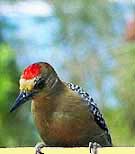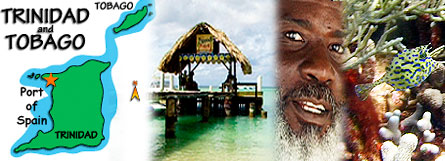 Music
is the food of life and in the Caribbean that means Carnival Time. To hear
local sounds and keep up with the soca and calypso music
click here
and here Music
is the food of life and in the Caribbean that means Carnival Time. To hear
local sounds and keep up with the soca and calypso music
click here
and here
 Just
South of Little Tobago on a dive site called Kelleston Drain lies the largest
recorded brain coral in the world, measuring 10ft by 16ft to see a picture
click here Just
South of Little Tobago on a dive site called Kelleston Drain lies the largest
recorded brain coral in the world, measuring 10ft by 16ft to see a picture
click here
 Inhabitants
of Tobago are called Tobagonians, Inhabitants of Trinidad are Trinidadians Inhabitants
of Tobago are called Tobagonians, Inhabitants of Trinidad are Trinidadians
 Tobago
was the location of the book "Robinson Crusoe" by Daniel Defoe, and is also
believed to be the place Robert Louis Stevenson had in mind when he wrote
Treasure Island. Tobago
was the location of the book "Robinson Crusoe" by Daniel Defoe, and is also
believed to be the place Robert Louis Stevenson had in mind when he wrote
Treasure Island.
 Tobago
took it's name from it's resemblance to a tobacco pipe, or "tavaco" used by local natives. Tobago
took it's name from it's resemblance to a tobacco pipe, or "tavaco" used by local natives.
 The
Caribbean Steel Pan, famous for music throughout the Islands was invented
here. The
Caribbean Steel Pan, famous for music throughout the Islands was invented
here.
 Tobago
has changes hands more than any other Caribbean Island, around 30 times before
the English finally settled in 1814 Tobago
has changes hands more than any other Caribbean Island, around 30 times before
the English finally settled in 1814
 Oil
was first found off the west coast of Trinidad in 1866, but production did not
begin until 1908. Oil
was first found off the west coast of Trinidad in 1866, but production did not
begin until 1908.
The first oil refinery in Trinidad was established in 1912, and Petroleum at
one point made Trinidad one of the richest colonies in the British Empire.
 The
language is English but a French patois is sometimes used.
The
currency of Trinidad and Tobago is the TT dollar as seen
here and gained independence in 1962. The
language is English but a French patois is sometimes used.
The
currency of Trinidad and Tobago is the TT dollar as seen
here and gained independence in 1962.
 Trinidad
is the larger of the two islands. It consists of 95% of the land mass and
Tobago the other 5%. Trinidad
is the larger of the two islands. It consists of 95% of the land mass and
Tobago the other 5%.
 The
climate is hot and humid. Temperature
is 78% daily; but a little cooler on Tobago. The
climate is hot and humid. Temperature
is 78% daily; but a little cooler on Tobago.
 There
is an airport on each island , two daily newspapers, a television station and
two major radio stations. There
is an airport on each island , two daily newspapers, a television station and
two major radio stations.
 Trinidad
and Tobago are known for creating the dances called
limbo and calypso. Trinidad
and Tobago are known for creating the dances called
limbo and calypso.
 The
official language is Trinidad English - English with influences of French and
Spanish. The
official language is Trinidad English - English with influences of French and
Spanish.
 Port
of Spain is the capital of Trinidad Port
of Spain is the capital of Trinidad
 Trinidad
&Tobago people call themselves Trinis. Trinidad
&Tobago people call themselves Trinis.
 The
taxis seat 9-25 people, called
a
Maxi Taxi. The
taxis seat 9-25 people, called
a
Maxi Taxi.
 The
literacy rate is 97% higher than the U.S. Every adult can read and write. The
literacy rate is 97% higher than the U.S. Every adult can read and write.
 Most
cars in Trinidad &Tobago are Japanese or German. Most
cars in Trinidad &Tobago are Japanese or German.
 The
police number is 999, 990 for an ambulance & fire. The
police number is 999, 990 for an ambulance & fire.
 The
people of Trinidad & Tobago say grace before they eat, they are very
religious. The
people of Trinidad & Tobago say grace before they eat, they are very
religious.
 The
law requires all children to go to school for only six years. The
law requires all children to go to school for only six years.
 David
Attenborough filmed past of his epic series "Trials of Life" on Little
Tobago David
Attenborough filmed past of his epic series "Trials of Life" on Little
Tobago
 Jacques
Cousteau filmed the reefs around Tobago Jacques
Cousteau filmed the reefs around Tobago
 The film "Swiss Family
Robinson was shot on location here
- twenty-two
weeks to shoot at a cost of $4.5 million. Jamaica,
Puerto Rico, Trinidad and the Galapagos islands were looked at before Tobago was
discovered. It was ideal for filming purposes, with one hitch: there were no
animals to be found. Thus, a menagerie was assembled - colourful tropical birds,
gulls, ostriches, snakes, tigers, zebras, baby elephants, monkeys - and flown to
the island, along with the appropriate trainers. The film "Swiss Family
Robinson was shot on location here
- twenty-two
weeks to shoot at a cost of $4.5 million. Jamaica,
Puerto Rico, Trinidad and the Galapagos islands were looked at before Tobago was
discovered. It was ideal for filming purposes, with one hitch: there were no
animals to be found. Thus, a menagerie was assembled - colourful tropical birds,
gulls, ostriches, snakes, tigers, zebras, baby elephants, monkeys - and flown to
the island, along with the appropriate trainers.
The director Ken Annakin recalls: There were fourteen trainers in all, and about
4:00 each day, they would come to me and say, "Mr. Annakin, can you tell me what
attitude you want from my animal tomorrow," and then they would discuss it and
put in last-minute work each night trying to get the desired results. One
afternoon at 3:30 our flamingos took off from Tobago and headed south to British
Guiana! We couldn't do anything about this, but fortunately the animal handler
was right, and they returned the next day at feeding time!
It took five months to build the necessary sets and incidental objects on
the island, including the wreckage, which was built on scaffolding at sea, with
divers participating. “It was absolutely real shooting,” says Annakin,
“something which appealed to me very much because of my documentary beginnings.
I liked shooting exteriors. I think it gives much more satisfaction to the
audience in the end, and in this case I wanted to keep very much away from the
original version that was made by RKO (in 1940), which we ran at Disney. It was
a good picture, but you could feel the restriction of them having to work in a
tank.”
But Annakin and the crew had to pay the price for realism; it took ten days to
shoot the sequence of floating the animals and supplies ashore. “The lines were
always getting crossed. You’d find a pig or a cow was tied with a barrel
underneath, he’d suddenly turn upside down, and the continuity girl on the
camera raft would suddenly shriek, and someone would have to dive in to put the
animal right so it wasn’t hurt.”
Every move, every shot was calculated in advance; Annakin, Bill Anderson,
Disney, a sketch artist named John Jensen, and
stuntman-turned-second-unit-director Yakima Canutt worked together on
storyboards, first deciding what they would like to do and then deciding if it
could be done. Disney was concerned that there should be something
happening every minute, particularly in the climactic pirate attack. He would
examine the storyboards and comment: “That works, that works, yeah, that works,
although there is a little hole here; we need a bit of action here. Devise some
action here.” And they would.
 The
Islanders have their own unique dialect. Here are some examples: The
Islanders have their own unique dialect. Here are some examples:
JUMBIE - ghost
MACAFOUCHETTE - meal left overs
MAMAGUY - make a fool of someone
MESS UP - spoil a good time
OUT DE LITE - turn off the light
TANTIE - auntie
MAKE STYLE - show off.
|

